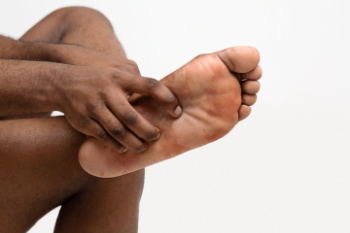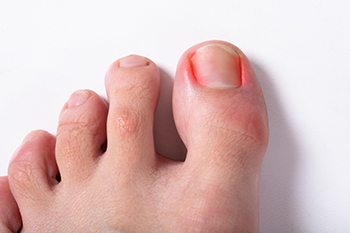Connect With Us
Blog
Items filtered by date: March 2025
Facts About Plantar Fasciitis

Plantar fasciitis is a major cause of heel pain. It occurs when the plantar fascia, a thick band of tissue along the bottom of the foot, undergoes degeneration at its attachment on the heel. This often leads to sharp pain near the heel, especially when standing up after rest. Plantar fasciitis is linked to excessive foot pronation, high or low arches and prolonged standing. Other factors include running, wearing improper footwear, and being overweight, along with tight calf muscles and a stiff Achilles tendon. A podiatrist can assess your foot structure, gait mechanics, and risk factors to determine the best course of treatment. Supportive footwear, custom orthotics, and stretching exercises may help reduce strain on the plantar fascia. If symptoms persist, a podiatrist may suggest corticosteroid injections to relieve inflammation or night splints to keep the fascia stretched. Surgery is considered when pain does not improve with other treatments. If you have symptoms of plantar fasciitis, it is suggested that you schedule an appointment with a podiatrist for an exam, diagnosis, and treatment options.
Plantar fasciitis is a common foot condition that is often caused by a strain injury. If you are experiencing heel pain or symptoms of plantar fasciitis, contact one of our podiatrists from Fox Valley Foot and Ankle Specialists. Our doctors can provide the care you need to keep you pain-free and on your feet.
What Is Plantar Fasciitis?
Plantar fasciitis is one of the most common causes of heel pain. The plantar fascia is a ligament that connects your heel to the front of your foot. When this ligament becomes inflamed, plantar fasciitis is the result. If you have plantar fasciitis you will have a stabbing pain that usually occurs with your first steps in the morning. As the day progresses and you walk around more, this pain will start to disappear, but it will return after long periods of standing or sitting.
What Causes Plantar Fasciitis?
- Excessive running
- Having high arches in your feet
- Other foot issues such as flat feet
- Pregnancy (due to the sudden weight gain)
- Being on your feet very often
There are some risk factors that may make you more likely to develop plantar fasciitis compared to others. The condition most commonly affects adults between the ages of 40 and 60. It also tends to affect people who are obese because the extra pounds result in extra stress being placed on the plantar fascia.
Prevention
- Take good care of your feet – Wear shoes that have good arch support and heel cushioning.
- Maintain a healthy weight
- If you are a runner, alternate running with other sports that won’t cause heel pain
There are a variety of treatment options available for plantar fasciitis along with the pain that accompanies it. Additionally, physical therapy is a very important component in the treatment process. It is important that you meet with your podiatrist to determine which treatment option is best for you.
If you have any questions, please feel free to contact our office located in Naperville, IL . We offer the newest diagnostic and treatment technologies for all your foot care needs.
Keep Your Feet Healthy So You Can Stay Active
Reduce Flat Feet Discomfort With Custom Orthotics

Flat feet? Rise above the discomfort with Custom Orthotics. Specifically designed to support the arch and align the foot, Custom Orthotics can be a game-changer for those with flat feet. They help in distributing weight evenly, preventing undue stress and potential pain. Walk, run, or stand with newfound confidence, knowing your feet have the support they've been missing. Want to explore the benefits of Custom Orthotics tailored for flat feet? Contact us today!
Addressing Toenail Fungus

Toenail fungus, also known as onychomycosis, is a common condition that causes discoloration, thickening, and brittleness of the toenails. The infected nail may appear yellow, white, or brown and may develop a foul odor. The condition is often painful, especially if the fungus spreads under the nail, leading to discomfort or a feeling of pressure. The main causes of onychomycosis include fungal exposure in warm, damp environments like public showers, gym locker rooms, or pool areas, as well as poor foot hygiene. Other factors like diabetes, a weakened immune system, or wearing tight-fitting shoes can also increase the risk. A podiatrist can diagnose toenail fungus through a physical exam or by sending a sample for lab testing. Treatment options include antifungal medication, either topical or oral, laser therapy, or in severe cases, removal of the infected nail. This type of doctor can also provide guidance on proper foot care and preventive measures to reduce the risk of recurrence. If you have this condition, it is suggested that you schedule an appointment with a podiatrist.
For more information about treatment, contact one of our podiatrists of Fox Valley Foot and Ankle Specialists. Our doctors can provide the care you need to keep you pain-free and on your feet.
Toenail Fungus Treatment
Toenail fungus is a condition that affects many people and can be especially hard to get rid of. Fortunately, there are several methods to go about treating and avoiding it.
Antifungals & Deterrence
Oral antifungal medicine has been shown to be effective in many cases. It is important to consult with a podiatrist to determine the proper regiment for you, or potentially explore other options.
Applying foot powder on the feet and shoes helps keep the feet free of moisture and sweat.
Sandals or open toed shoes – Wearing these will allow air movement and help keep feet dry. They also expose your feet to light, which fungus cannot tolerate. Socks with moisture wicking material also help as well.
If you have any questions please feel free to contact our office located in Naperville, IL . We offer the newest diagnostic tools and technology to treat your foot and ankle needs.
Custom Orthotics for Flat Feet

Flat feet can lead to discomfort, fatigue, and even pain in the ankles, knees, hips, or lower back. Without proper arch support, the foot collapses inward, straining muscles and joints. Custom orthotics provide targeted support by stabilizing the arch, improving alignment, and distributing pressure evenly across the foot. Unlike generic insoles, custom orthotics are designed specifically for your foot structure. They help correct overpronation, reduce strain on tendons, and improve overall biomechanics. Whether you stand all day, run frequently, or experience chronic foot pain, orthotics can make daily activities more comfortable and prevent long-term issues. If you have pain from having flat feet, it is suggested that you see a podiatrist who can assess your gait, foot shape, and specific needs to create the right orthotic solution for you.
Experience a transformative solution to heel pain and foot pain through the personalized benefits of custom orthotics and shoe inserts. If you’re grappling with the persistent agony of plantar fasciitis, these customized inserts are designed to alleviate the strain on the plantar fascia, providing targeted relief. Engineered to adapt to your unique foot anatomy, custom orthotics tackle not only plantar fasciitis but also general foot and heel pain, offering unparalleled support and comfort. Don’t let every step be a reminder of discomfort; step into a world of tailored well-being. Say farewell to the limitations imposed by heel pain and embrace the freedom of pain-free mobility. Invest in your foot health and redefine your daily stride with the transformative power of custom orthotics and shoe inserts, ensuring each step is a step towards lasting comfort.
If you have any questions please contact our office located in Naperville, IL . We offer the newest diagnostic and treatment technologies for all your foot and ankle needs.
Treatment Options for Overpronation

Overpronation occurs when the foot rolls excessively inward with each step, placing abnormal stress on the arches, ankles, and toes. Treatment for overpronation primarily involves relieving this pressure to reduce pain or discomfort in the feet and ankles. Wearing supportive footwear, featuring firm cushioning around the heel and midfoot, can help limit unnecessary foot motion and stabilize the arch. Custom orthotics may be prescribed by a podiatrist to offer individualized foot support, effectively aligning and stabilizing the feet and ankles. In moderate cases, kinesiology taping or braces are beneficial in providing extra support, improving foot alignment, and preventing further pronation. In rare instances, severe overpronation due to flat feet or structural damage might require surgery. Such procedures typically involve reconstructing or realigning foot bones and tendons to stabilize the arch, correct the foot's alignment, and relieve symptoms. If you suspect you have a pronation problem, it is suggested that you schedule an appointment with a podiatrist for an exam, diagnosis, and treatment.
If you have any concerns about your feet, contact one of our podiatrists from Fox Valley Foot and Ankle Specialists. Our doctors can provide the care you need to keep you pain-free and on your feet.
Biomechanics in Podiatry
Podiatric biomechanics is a particular sector of specialty podiatry with licensed practitioners who are trained to diagnose and treat conditions affecting the foot, ankle and lower leg. Biomechanics deals with the forces that act against the body, causing an interference with the biological structures. It focuses on the movement of the ankle, the foot and the forces that interact with them.
A History of Biomechanics
- Biomechanics dates back to the BC era in Egypt where evidence of professional foot care has been recorded.
- In 1974, biomechanics gained a higher profile from the studies of Merton Root, who claimed that by changing or controlling the forces between the ankle and the foot, corrections or conditions could be implemented to gain strength and coordination in the area.
Modern technological improvements are based on past theories and therapeutic processes that provide a better understanding of podiatric concepts for biomechanics. Computers can provide accurate information about the forces and patterns of the feet and lower legs.
Understanding biomechanics of the feet can help improve and eliminate pain, stopping further stress to the foot.
If you have any questions please feel free to contact our office located in Naperville, IL . We offer the newest diagnostic and treatment technologies for all your foot and ankle needs.
What Is an Ingrown Toenail?

An ingrown toenail occurs when the edge of the nail grows into the surrounding skin, leading to pain and irritation. This condition commonly affects the big toe and can result in redness, swelling, and tenderness along the nail border. In more severe cases, infection may develop, causing increased pain, drainage, or pus formation. Wearing tight shoes, trimming nails too short, or cutting them at an angle increases the risk of developing an ingrown toenail. Injury to the toe or genetic factors that cause curved nails may also contribute to the problem. Proper nail care, including straight trimming and wearing well-fitted shoes, can help prevent this condition. Ingrown toenails can cause pain and discomfort that make it difficult to complete daily activities. If you have developed this condition, it is suggested that you consult a podiatrist who can offer appropriate treatment methods.
Ingrown toenails may initially present themselves as a minor discomfort, but they may progress into an infection in the skin without proper treatment. For more information about ingrown toenails, contact one of our podiatrists of Fox Valley Foot and Ankle Specialists. Our doctors can provide the care you need to keep you pain-free and on your feet.
Ingrown Toenails
Ingrown toenails are caused when the corner or side of a toenail grows into the soft flesh surrounding it. They often result in redness, swelling, pain, and in some cases, infection. This condition typically affects the big toe and may recur if it is not treated properly.
Causes
- Improper toenail trimming
- Genetics
- Improper shoe fitting
- Injury from pedicures or nail picking
- Abnormal gait
- Poor hygiene
You are more likely to develop an ingrown toenail if you are obese, have diabetes, arthritis, or have any fungal infection in your nails. Additionally, people who have foot or toe deformities are at a higher risk of developing an ingrown toenail.
Symptoms
Some symptoms of ingrown toenails are redness, swelling, and pain. In rare cases, there may be a yellowish drainage coming from the nail.
Treatment
Ignoring an ingrown toenail can have serious complications. Infections of the nail border can progress to a deeper soft-tissue infection, which can then turn into a bone infection. You should always speak with your podiatrist if you suspect you have an ingrown toenail, especially if you have diabetes or poor circulation.
If you have any questions, please feel free to contact our office located in Naperville, IL . We offer the newest diagnostic and treatment technologies for all your foot care needs.

